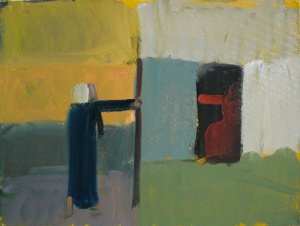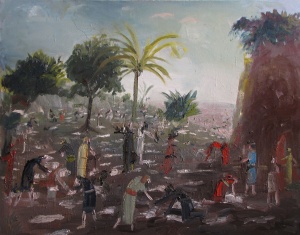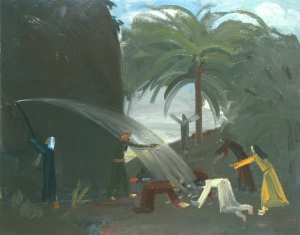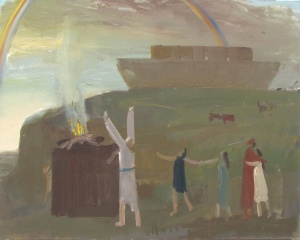John Bradford: Painting the Biblical Narrative
John Bradford has devoted the vast majority of his creative life to a visual exploration of the Hebrew Bible. I have reviewed many of his exhibitions over the last ten years and his dedication to explicating the biblical narrative is unimpeachable. My question concerning his latest exhibition at the Bowery Gallery from November 30–December 31, 2010 is simple: is depicting a straightforward image of the narrative enough?
The range of subjects from Tanach is, as usual, impressive: Noah’s Sacrifice, The Stolen Blessing, Jacob, Laban, Leah and Rachel, Judah and Tamar, Manna, Miriam’s Leprosy, Moses Striking the Rock, David, Absalom and Tamar and finally the Rape of Tamar. Stylistically the paintings can be divided into two categories. The “figures in landscape” are highlighted with beautiful touches of naturalist observations such as luminous clouds and luxurious palm trees. These works contrast with the much more abstract, dark and barren interiors frequently illuminated by a rectangular doorway or window that affords a glimpse of landscape and light. Throughout the protagonists are minimally depicted, mere suggestions of limbs and heads. All are clad in “biblical” robes. The expressionistic handling of paint and expressive gestures of all the figures drives the specific narrative content.

Bradford’s purpose at first appears to be a literal depiction of the biblical text. Judah and Tamar shows a man with a long staff standing outside a squarish tent with a figure just visible inside. Just about as straightforward as you can get, even though the tent is a non-textual addition that may simply stand for the intimate relations the narrative relates.

Similarly, Bradford’s painting of Manna is a pleasant landscape of a field dotted with trees and palms, an impressive cliff on the right and scores of people picking up some kind of white stuff off the ground. Manna.

Striking the Rock is a landscape dominated by a huge rock on the left and palm trees on the right. A figure strikes this rock with a rod and water gushes out to the delight of the people assembled. An ill-fated miracle.
As in all serious biblical paintings much more is needed to decipher these deceptively simple images. The biblical text must be scrutinized and interpreted to allow us to understand the artist’s interpretation and meaning. In Judah and Tamar the use of the tent as a symbol for a place of conception is only the beginning of Bradford’s metaphor. Suddenly the intense rectilinear composition operates less as a “figures-in-landscape” theme and becomes considerably more conceptual. The rectangles of her world (the tent, the tent doorway, her body) are now seen as locked in a grid of Judah’s world of a harsh horizon and rigid staff. Judah has suffered the premature death of two sons and is faced with the very real possibility of becoming heirless. Easily as much as Tamar, his life has been blocked and frustrated just as the painting locks them together.
For the viewer, knowing an artist’s interpretive sources; midrashim and commentators whether ancient or contemporary, is frequently as important as knowing the biblical text. For John Bradford, long-time friend, rabbi and political thinker Avi Berkowitz is his primary influence on the biblical narrative. Berkowitz, resident of Efrat, Israel, produces a weekly parsha sheet that Bradford has followed closely for many years. Additionally Bradford continues to have an ongoing dialogue with Berkowitz because he sees their relationship as an “entire enterprise and approach… that I am inspired by [his] way to integrate learned halachic analyses with their current political implication as a unified concept.”

Noah’s Sacrifice shows Noah raising his arms before an altar with a burning sacrifice. Behind him is his family gesturing also in praise, all set against a mountain with a huge ark silhouetted against a late afternoon sky. A bright rainbow arches up from the ark and reappears in the far left corner of the image. Without the benefit of commentary it is a rather benign image.
Berkowitz observes that the original Adam was created by God Himself “ex-nihilo.” After his sin and expulsion he became Adam II, a man of the earth, “liberated from the confines of the Garden and empowered to create and recreate the world in their image, quickly become deformed… cleaving to a lifestyle structured around mindless debauchery and bottomless decadence.” Finally this kind of human had to be destroyed. But “sadly, when the flood waters receded, nothing had changed.” Noah immediately produces wine and is drunkenly exposed and debauched. The world would soon attempt to challenge God Himself with the Tower of Babel. In spite of this sorted history, God makes a pledge in the form of the rainbow, “a grand coalition between Creator and created… the multi-colored symbol of God’s ability to accept man’s unbridled decadence…” Bradford’s painting is now transformed. It is the rainbow that Noah and his family are celebrating, ironically understanding that it in effect gives them license not to change their evil ways.
Striking the Rock brings us to a similarly critical analysis of the text. Berkowitz sees Moses’ use of his staff to strike the rock as a tragic failure of his leadership. He has willfully relied on the magical staff and his own charisma it symbolizes to sanctify God, in effect “failing to use the opportunity to sanctify God’s name among the people by demonstrating His authority over nature.” The staff is the symbol of raw power that God had wanted replaced by the power of the word, something that if Moses would have obeyed would have been a “paradigm shift in human relations… [to] expel violence and exploitation from the affairs of men, replacing the logic of force with the force of logic.”
Revisiting Bradford’s painting the image becomes tragic. The enormous rock now becomes symbolic of Moses’ powerlessness, engulfing him just as the people are senselessly scampering to gather up the water. It is a scene of chaos and disorder, certainly not a fitting preparation for the nation of Israel to enter the Promised Land. The only figure who seems to be aware of what has happened is right in the center, silhouetted against the sky, his arms thrust out in horror and despair.
Biblical painting, much like the Torah itself, cannot be taken at face value. It must be seen in the context of its texts and commentaries, constantly measured against its sources in order to begin to fully reap its bounty. Bradford’s paintings are considerably more complex than they seem, and we are all the better for it.